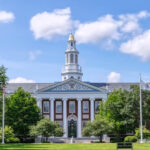College Rankings Deconstructed
Every year millions of American parents and students pore over U. S. News and World Report’s college rankings to select the institution of higher learning of their choice. Meanwhile, inside the Ivory Tower, the denizens may have a different reaction to the famous survey.
“I just throw my U. S. News survey in the trash,” Patricia A. McGuire, the president of Trinity College says.
“We got this job by default,” Brian Kelly of U. S. News says. “We get more information out of administrators than they divulge elsewhere.” But what good is it?
“U. S. News does not rank schools by learning but by what their students learned before they got there,” Kevin Carey, a policy analyst with the Education Sector says. The Education Sector sponsored a conference on college rankings at which McGuire, Kelly and Carey spoke.
“The U. S. News rankings look at money [spent on behalf of students], star faculty, research and SAT scores going in,” Carey avers. Here, according to U. S. News itself, are the criteria that the magazine uses in evaluating schools:
• “Peer assessment score (5.0=highest)
• “Average freshman retention rate
• “2005 actual graduation rate
• “Faculty resources rank
• “% of classes w/50 or more (’05)
• “% faculty who are full time (’05)
• “SAT/ACT 25th-75th percentile (’05)
• “Acceptance rate (’05)” and the
• “Alumni giving rank”
When the Washington Monthly, a publication less widely known than U. S. News, got into the rankings game, its findings were the reverse of its more famous and better-financed rival. “In our rankings, Texas A & M comes in fifth and Princeton is 23rd,” Paul Galistos, who works for The Washington Monthly, says. By way of comparison, U. S. News ranks Princeton number one and Texas A & M number 60.
Here are the U. S. News Top Ten. You can do an interesting experiment by cutting and pasting the name of the institution in the search box on Accuracy in Academia’s www.campusreportonline.net. As you can see, the U. S. News rankings tilt heavily towards the Ivy Leagues:
• Princeton
• Harvard
• Yale
• California Institute of Technology
• Stanford
• MIT
• University of Pennsylvania
• Duke
• Dartmouth
• Columbia
“You classify some at the expense of others,” Trinity College president McGuire told Kelly of the U. S. News & World Report of his magazine’s rankings. U. S. News ranks 1,500 colleges and universities, Kelly says. That would be about a quarter of the number of such institutions in the United States.
Dave Dunn was there from the U. S. Department of Education but did not exactly give a ringing endorsement of the data collected by that federal agency: “The Department of Education collects reams of data on education but the data is not oriented to the key function of the university—learning.”
But where do you start? McGuire offers an interesting caveat. “Grades and rankings are irrelevant,” she claims. The head of the U. S. Secretary of Education’s commission on the future of higher education came to a somewhat similar conclusion. By way of example, McGuire pointed out that “Alverno is widely recognized as among the best” of American colleges.
Alverno is a small Catholic women’s college in Milwaukee that has largely done away with grades. “The college has integrated assessment into its entire curriculum, evaluating students in ‘real life’ situations on how well they have mastered the subject matter and on eight specific abilities, including communication and problem solving,” Burton Bollag explains in the October 27th Chronicle of Higher Education. “For example, psychology students are asked to take a 3-year-old child to lunch and analyze the child’s behavior on the basis of child-development theories they have studied.”
“In an English course, ‘Practicing Literary Criticism,’ students pretend to be school-board members discussing whether to approve the use of a Toni Morrison novel that some say is unsuitable for high-school students.”
Malcolm A. Kline is the executive director of Accuracy in Academia.




